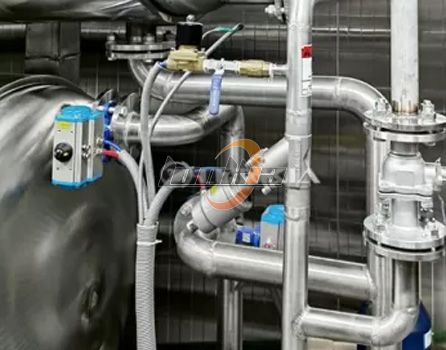When it comes to food safety, shelf-life extension, and large-scale production, few technologies are as vital as the process retort. Used in both industrial and commercial food processing, a process retort is a pressure vessel designed to sterilize food products after they have been sealed in containers—whether those containers are metal cans, glass jars, or retort pouches. This method is also known as thermal processing or retort sterilization and is essential in ensuring that ready-to-eat foods remain safe and stable without refrigeration.

What Is a Process Retort?
A process retort is a specialized machine that applies heat and pressure to packaged food for a specified time. The purpose is to destroy bacteria, yeasts, molds, and other microorganisms that can spoil food or pose health risks. What makes a retort unique is that it sterilizes food in its final packaging, thereby preventing post-process contamination and allowing for longer shelf life under ambient conditions.
There are different types of process retorts—steam retorts, water spray retorts, steam-air retorts, and rotary retorts, each suited for specific food types and container materials. Despite their differences, all retorts operate under a common principle: controlling temperature, pressure, and time to meet the required lethality levels without damaging food quality.
Why Is the Process Retort Important?
The process retort plays a critical role in food safety compliance and product quality. It ensures that food manufacturers can meet international standards such as FDA and USDA guidelines while also delivering consistent texture, flavor, and nutritional value. It also enables global food distribution by extending shelf life without the need for freezing or refrigeration.
In sectors like military rations, pet food, baby food, and shelf-stable meals, retorting is indispensable. It’s also an environmentally conscious choice, reducing reliance on cold chain logistics and minimizing food waste due to spoilage.
Key Phases of the Retort Process
A typical retort process involves several precise steps:
1. Come-Up Time (CUT)
This is the heating phase where the retort chamber gradually reaches the target processing temperature, usually between 116°C and 130°C (240°F to 266°F). During this phase, the internal temperature of the food also starts to rise.
2. Sterilization or Holding Phase
Once the desired temperature is achieved, the product is held at that temperature for a defined period. This is the most critical step for microbial kill and ensures food safety and commercial sterility.
3. Cooling Phase
After the hold time, the temperature in the retort is slowly reduced using cool water or air, depending on the type of retort system. The cooling must be gradual to avoid container deformation or product quality loss.
4. Depressurization and Unloading
Once the pressure and temperature reach safe levels, the containers are unloaded, labeled, and packed for distribution.
Factors That Influence Retort Processing
Several factors must be carefully controlled to ensure an effective retort process:
Container size and material: Larger containers or non-metallic packaging like pouches require modified time-temperature combinations.
Product consistency: Liquids heat faster than solids; therefore, viscosity and density impact heat penetration.
Headspace and fill ratio: Improper fill levels can affect heat distribution inside the package.
Equipment calibration: Regular validation and maintenance ensure accurate pressure and temperature control.
Types of Process Retort Systems
Static Retorts
Used for solid or uniform products like canned vegetables and soups. The containers remain stationary during processing.
Rotary Retorts
These systems rotate the containers to promote even heat distribution. Ideal for products like rice meals, pasta, or thick sauces.
Water Spray and Water Immersion Retorts
Suitable for delicate packaging materials such as pouches and plastic containers. Water acts as the heat transfer medium and minimizes the risk of container damage.
Steam-Air Retorts
Used for containers that require air-over-steam heating. They maintain consistent temperature and pressure, ideal for large batch processing.
Advantages of Using a Process Retort
- Enhanced food safety: Eliminates pathogens like Clostridium botulinum.
- Long shelf life: Enables room temperature storage for months or even years.
- Product versatility: Applicable to a wide range of food types.
- Regulatory compliance: Meets international food safety standards.
- Sustainability: Reduces energy usage compared to frozen or refrigerated supply chains.
Challenges in Retort Processing
Despite its benefits, retorting presents a few challenges:
- Overprocessing: Excess heat can degrade nutrients or change the flavor.
- Container deformation: Inconsistent pressure control can lead to bulging or collapsed containers.
- Complex validation: Ensuring uniform heat penetration requires detailed thermal mapping and frequent testing.
Manufacturers address these issues through automation, real-time monitoring systems, and by customizing retort profiles for each product type.
Innovations in Retort Technology
Modern retorts are far more advanced than earlier models. Many feature:
- Automated recipe controls
- SCADA systems for data logging
- Advanced rotary mechanisms
- Energy-efficient designs
- Remote maintenance and diagnostics
These upgrades reduce human error, improve batch traceability, and ensure higher throughput with better product safety.
The process retort remains a cornerstone of food processing technology. Whether you're manufacturing meals ready to eat (MREs), shelf-stable pet food, or gourmet sauces, a well-designed retort system ensures your product meets safety standards without compromising taste or texture. As consumer demand for convenience and food safety continues to grow, investing in the right retort process is not just smart—it's essential for success in the modern food industry.

